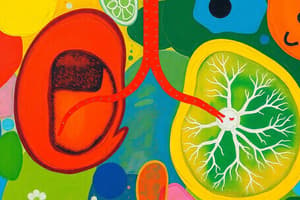Podcast
Questions and Answers
Which statement could be categorized only in the anaerobic section of the Venn diagram comparing aerobic and anaerobic respiration?
Which statement could be categorized only in the anaerobic section of the Venn diagram comparing aerobic and anaerobic respiration?
- Regenerates NADH
- Is performed by eukaryotes
- Occurs in the mitochondria
- Has commercial uses (correct)
What do alcohol fermentation, acetyl CoA formation, and the Krebs cycle have in common?
What do alcohol fermentation, acetyl CoA formation, and the Krebs cycle have in common?
- All produce ATP
- All produce alcohol
- All produce water
- All produce carbon dioxide (correct)
Which statement describes the reaction for cellular respiration?
Which statement describes the reaction for cellular respiration?
- The equation is glucose + oxygen = carbon dioxide + water and energy is produced in the form of ATP (correct)
- The equation is carbon dioxide + water = glucose + oxygen + water and energy is produced in the form of ATP
- The equation is glucose + oxygen = carbon dioxide + water and energy is required in the form of light
- The equation is carbon dioxide + water = glucose + oxygen + water and energy is required in the form of light
During which process is water produced?
During which process is water produced?
Which is a similarity between alcohol fermentation and aerobic respiration?
Which is a similarity between alcohol fermentation and aerobic respiration?
What do aerobic respiration and anaerobic respiration have in common?
What do aerobic respiration and anaerobic respiration have in common?
Which statement about anaerobic respiration is true?
Which statement about anaerobic respiration is true?
During the citric acid cycle, what happens to acetyl-CoA?
During the citric acid cycle, what happens to acetyl-CoA?
What is the main transformation that occurs during glycolysis?
What is the main transformation that occurs during glycolysis?
Which statement should be categorized only in the aerobic section of the Venn diagram comparing aerobic and anaerobic respiration?
Which statement should be categorized only in the aerobic section of the Venn diagram comparing aerobic and anaerobic respiration?
Which theory might be supported by the information that a virus was capable of infecting another virus?
Which theory might be supported by the information that a virus was capable of infecting another virus?
Which structure has the least effect on the ability of a virus to infect and replicate in a host cell?
Which structure has the least effect on the ability of a virus to infect and replicate in a host cell?
Which occurs in both the lytic cycle and the lysogenic cycle?
Which occurs in both the lytic cycle and the lysogenic cycle?
What usually happens to the host's DNA during the lytic cycle?
What usually happens to the host's DNA during the lytic cycle?
Which is included in a lysogenic cycle?
Which is included in a lysogenic cycle?
Which component of a virus is injected into an infected cell?
Which component of a virus is injected into an infected cell?
Which argument supports the idea that viruses are alive?
Which argument supports the idea that viruses are alive?
Which best describes viruses?
Which best describes viruses?
Flashcards are hidden until you start studying
Study Notes
Respiration Processes
- Aerobic respiration occurs in the mitochondria and produces water, while anaerobic respiration has commercial applications.
- Both aerobic and anaerobic respiration start with glycolysis, converting glucose to pyruvate.
- Anaerobic respiration is utilized in the production of beer, wine, bread, yogurt, and cheese.
Cellular Respiration Equation
- The equation for cellular respiration is glucose + oxygen = carbon dioxide + water, generating energy in the form of ATP.
- This process contrasts with the equation where carbon dioxide and water produce glucose and oxygen, which requires light energy.
Glycolysis
- Glycolysis breaks down glucose into two pyruvate molecules, producing ATP and NADH while oxidizing glucose.
- During glycolysis, 2 ATP are used, and 4 ATP and 2 NADH are produced.
Citric Acid Cycle
- Acetyl-CoA enters the citric acid cycle, where it combines with a 4-carbon molecule to form citric acid and regenerates the 4-carbon molecule through redox reactions.
Viruses
- Viruses are classified as nonliving infectious agents, containing unique genetic material and requiring a host for replication.
- The ribosome has minimal impact on a virus's ability to infect host cells, while the nucleic acid component is injected into the infected cell.
Viral Life Cycle
- The lytic cycle results in the destruction of the host DNA, while the lysogenic cycle integrates viral genetic information without immediate destruction.
- Both cycles hijack the host cell's metabolism, leading to viral replication.
Arguments on Viruses' Status
- Support for viruses being classified as alive includes their ability to replicate within a host and possess unique genetic information, while they do not have a cell membrane or produce proteins independently.
Studying That Suits You
Use AI to generate personalized quizzes and flashcards to suit your learning preferences.




